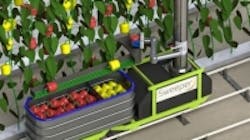Vegetable harvesting robot being developed by European Commission
Coordinated by Wageningen University and Research Centre in The Netherlands, an international team of researchers are collaborating to develop the "SWEEPER" greenhouse harvesting robot.
MORE ARTICLES
Computer vision platform being developed by European Commission
Vision-guided robot helps make new discoveries under the ice in Antarctica
The project involves six partners from four different countries (The Netherlands, Belgium, Sweden, and Israel). The partners consist of research and academic organizations (Wageningen University and Research Center, UMEA University, Proefstation voor de Groenteteelt, and Ben-Gurion University of the Negev), a system integrator (Irmato Industrial Solutions Veghel B.V), and a grower of sweet peppers (De Tuindershoek). These companies, according to the project page, provide expertise in horticultural engineering, machine vision, robotics, sensing, control, intelligent systems, system integration, software architecture, and greenhouse crop management.
SWEEPER team members look to build upon a previous robot that harvested sweet peppers, which was developed in the European project called CROPS. This particular robot consisted of a carrier platform that held a robot arm that gripped and cut the peppers, a compressor for pneumatics, control electronics, illumination rig, and computers and sensors for fruit and obstacle detection.
In the final demonstration with this robot, localization of ripe peppers took place at two different stages. First, a side view image of the canopy is taken by a color camera and Time of Flight camera. The images from both cameras are then combined to include the 3D data in the visible image. After positioning the arm in front of the target, a color camera and 3D camera integrated into the robotic hand are used to recalculate the position of the pepper. Two color cameras on the main platform were used to capture baseline stereo images, from which the robot was able to able to detect objects.
From there, two different end-effectors (The device on the end of the robotic arm) designed to detach the vegetable were developed and analyzed: A gripper with an integrated cutting tool with fingers, and another guidance and cutting tool.
With SWEEPER, the team is looking to improve upon this project and advance the competitiveness of the European greenhouse sector, which currently faces a low availability of skilled workforce. SWEEPER is a €4 million project that was chosen to be part of the European Commission’s Horizon 2020 (H2020) framework, which provides nearly €80 billion in funding for research and innovation for purposes of driving economic growth and creating jobs.
View the project page.
Share your vision-related news by contacting James Carroll, Senior Web Editor, Vision Systems Design
To receive news like this in your inbox, click here.
Join our LinkedIn group | Like us on Facebook | Follow us on Twitter | Check us out on Google +
About the Author

James Carroll
Former VSD Editor James Carroll joined the team 2013. Carroll covered machine vision and imaging from numerous angles, including application stories, industry news, market updates, and new products. In addition to writing and editing articles, Carroll managed the Innovators Awards program and webcasts.
